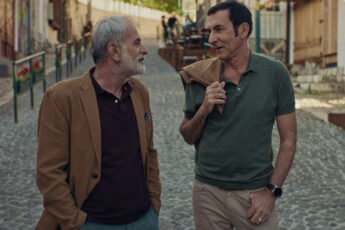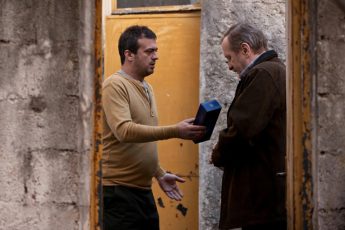Take Me to... a Place I Can Call Mine
Ena Sendijarević’s Take Me Somewhere Nice (2019)
Vol. 91 (January 2019) by Anastasia Eleftheriou
Ena Sendijarević’s first feature Take Me Somewhere Nice premiered in competition at the IFFR on Saturday and took us on a cinematic road trip towards the discovery of the identity and sexuality of a young girl of Bosnian origin.
Alma (Sara Luna Zorić) lives in the Netherlands with her mother when she decides to take a trip to Bosnia to meet her presumably sick father, whom she has never met. Helped by her mother to organize her trip home, meet her cousin Emir (Ernad Prnjavorac) and reach her father, Alma’s journey at the threshold of adulthood is not just about wandering through the forsaken countryside of the Balkans, but rather an existential adventure in which she discovers her national and sexual identity.
As she reaches Bosnia, her cousin seems less than keen to be of any help in taking her to the hospital where her father is supposed to be. However, Emir’s best friend Denis (Lazar Dragojević) is attracted to the newcomer, both due to her appearance but also due to what she represents as a young girl who made it out of Bosnia. Alma and Denis’ encounter turns out to be passionate, at least for a while.
Ena Sendijarević introduces the conflicting relationship her protagonist has with her identity early on. Upon her arrival in Bosnia Alma changes her hair color, in an apparent effort to fit in with the country’s perception of what adult females should look like. We see her walking breezily, wearing only the beautiful blue summer dress she and her mother bought for this trip, and carrying a plane suitcase. At times, we wonder how she keeps her purse and phone (which she uses frequently to call her mother) – she seems to have no pockets and her suitcase is locked. Yet her hands are free most of the time. Soon we realize that none of these realistic elements matter as Alma’s tender, beautiful and plane existence is symbolized by the airy dress she’s wearing; she seems to be as little attached to her belongings as to her roots. Her soul is wondering free, most often in nature, regardless of her lack of direction.
Alma tries to find a way to reach the hospital where her father is all by herself, since neither her cousin or his friend, seem to want to help her in the beginning. She embarks on a trip to the country of Bosnia and takes us along, introducing us to people and landscapes, the cinematographic take on the landscape being much newer and fresher to the eye of the foreign viewer than the take on representations of Balkan people; multiple times we’ve seen edgy characters from the region of the Kusturica type, not to mention foreign directors who try to depict the typical “Balkan” type in your average action-hero foe. It is thus all the more refreshing to get a glimpse of unscathed beauty in a depiction of the country of Bosnia, its wild beaches, lost highways, dramatic light.
As the trio’s road trip evolves, with all its difficulties, suspense, unpredicted turns of events etc., Alma’s identity and sexuality issues come affront. What does she feel like when in Bosnia? What was she like in the Netherlands? With her mother and father representing two different identities, where does she really belong? And what does it mean to be a young female adult? Sometimes she longs for emancipation and autonomy, sometimes she clearly requires protection. These conflicting psychological conditions are further complicated through the discovery of her own sexuality, in which she is torn between hyper-sexualized desire and romantic ideals of love.
Alma’s troubling thoughts are hardly ever expressed in words, nor are those of her co-travelers as a matter of fact (except when her cousin expresses his patriotic views on the country, which as he also says, he’d be more than glad to leave). Landscapes, gestures, and sound portray the characters’ inner world, for instance when Alma and the two boys take drugs and start doughnut driving their car, or when the three of them walk alone along the train rails, heading into a tunnel. This symbolic filmmaking culminates in a dream sequence where Alma dreams of attending a magician’s show in Bosnia and is chosen among the crowd to be the one whose body will be cut in half.
Beauty is generously offered to the viewer, with interesting angles of shots, exquisite lighting, impressing landscapes, and Alma’s sex appeal provoking the viewer’s sexual projections, albeit somewhat too copiously. Equally generous is the amount of tenderness, however, with touches and signs of care and sensation expressed between the characters. However, one may wonder why this beauty was less generously distributed with regards to Bosnia; unpleasant bus rides, lost baggage replaced by a suitcase with drugs, police checks in the middle of nowhere, a man dying with no friends to attend his funeral, unemployment, singer-prostitutes, tacky night clubs, and finally raw violence for the sake of violence come to overshadow the beauty of the country’s picturesque landscapes. They also seem to be unfairly juxtaposed with the Netherlands being “a cold country with cold people, who won’t be nice to immigrants”, as expressed through Alma’s words (and not images) at different times of the film.
If this journey was meant to be more poetically-existential than sociologically realistic – Alma’s airy blue dress reflecting the meaning in her name – then why is Bosnia draped in rags? What does it say about the girl’s – or even the director’s – sentiments about Bosnia? Burgeoning identitary struggles of nationalism and xenophobia in Europe, have certainly made it difficult for sensitive teenagers all across Europe to belong somewhere. Nevertheless, one may wonder whether the conflicting portrayal of the Balkans as Europe’s underdeveloped hinterlands on the one hand, and the Netherlands as a comfort zone to return to on the other, will satisfy a teenager’s need for “feeling at home”. In the end, the film essentially shares the conflict of its main character: it seems unable to step outside of its dreams of harmony to see the world as it really is. Nevertheless, the cinematographic storytelling, which relies on images and sensations more than on well-structured narrative and dialogue, is enough for the viewer to plunge in and indubitably a beautiful experience on screen.




Leave a Comment